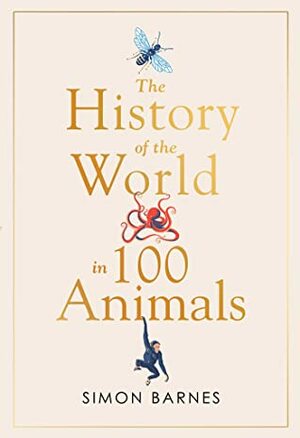
The History of the World in 100 Animals
by Simon Barnes
Genres: History, Non-fiction, SciencePages: 416
Rating:

Synopsis:We are not alone. We are not alone on the planet. We are not alone in the countryside. We are not alone in cities. We are not alone in our homes. We are humans and we love the idea of our uniqueness. But the fact is that we humans are as much members of the animal kingdom as the cats and dogs we surround ourselves with, the cows and the fish we eat, and the bees who pollinate so many of our food-plants.
In The History of the World in 100 Animals, award-winning author Simon Barnes selects the 100 animals who have had the greatest impact on humanity and on whom humanity has had the greatest effect. He shows how we have domesticated animals for food and for transport, and how animals powered agriculture, making civilisation possible. A species of flea came close to destroying human civilisation in Europe, while the slaughter of a species of bovines was used to create one civilisation and destroy another. He explains how pigeons made possible the biggest single breakthrough in the history of human thought. In short, he charts the close relationship between humans and animals, finding examples from around the planet that bring the story of life on earth vividly to life, with great insight and understanding.
The heresy of human uniqueness has led us across the millennia along the path of destruction. This book, beautifully illustrated throughout, helps us to understand our place in the world better, so that we might do a better job of looking after it. That might save the polar bears, the modern emblem of impending loss and destruction. It might even save ourselves.
I really enjoy books that try to tell a history through a number of objects or people or, in this case, animals. Simon Barnes’ A History of the World in 100 Animals is more or less that, but it was marred for me by the fact that I couldn’t actually determine any governing organisation here, not even alphabetical. The stories did all pick up on the theme of how humans have interacted with animals, of course, but they didn’t lead into each other — animals which shared a similar theme could be separated by most of the book. They weren’t organised by type of animal, or location, or type of interaction… any organising principle that I could think of.
As such, it felt like a bit of a weird read, whipping from one topic to another. There are certainly ways to organise this kind of book (chronologically, for instance), which would’ve made it flow better.
That said, there are certainly some fascinating stories of human interaction with animals (and it is pretty much all about human interaction with animals in one way or another). Where I know my stuff, it’s accurate, though the utter lack of footnotes or bibliography is worrisome.
It’s beautifully presented, with matte colour images accompanying many (if not all) of the stories).
Rating: 3/5

Leave a Reply